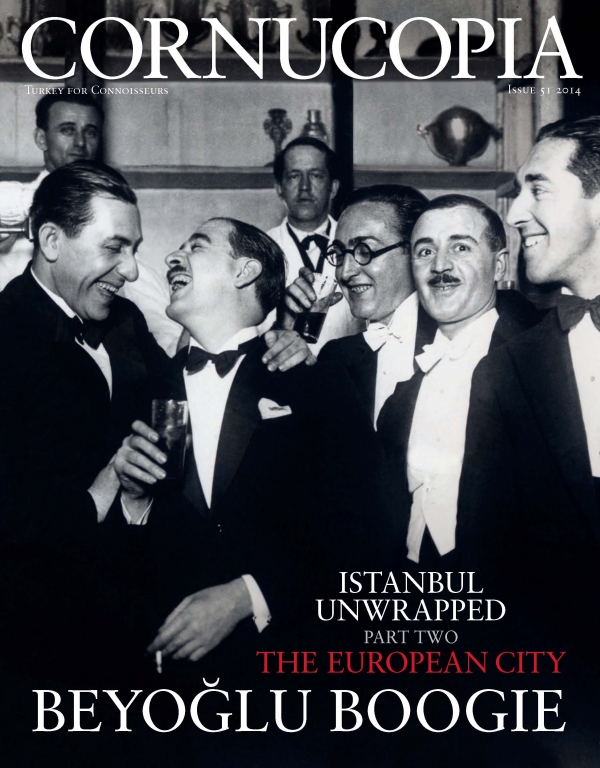Buy or gift a stand-alone digital subscription and get unlimited access to dozens of back issues for just £18.99 / $18.99 a year.
Please register at www.exacteditions.com/digital/cornucopia with your subscriber account number or contact subscriptions@cornucopia.net
Buy a digital subscription Go to the Digital EditionThe former embassies of Ottoman Istanbul have more of a consular role today but they still evoke the diplomatic rituals of their nineteenth century heyday. In the first of two articles Patricia Daunt traces the history of these spectacular winter palaces, and Fritz von der Schulenburg assembles a unique photographic record of the treasures they contain
The embassies may have moved to Ankara, but the splendour of the best diplomatic bricks and mortar of the imperial age remains in the Istanbul quarter of Beyoğlu, the old Pera of cosmopolitan Constantinople. They are the grandest 19th-century diplomatic buildings of any of the imperial capitals and, with the exception of the Venetian palace, are all more or less contemporary in date.
Trade with the Ottoman Empire, the raison d’etre of the foreign community of Constantinople, brought diplomatic missions in its wake. At first the embassies were established near their traders’ factories around the harbour of Galata, jostling the Genoese, Anconite, Ragusan, Pisan and Florentine merchants and at the mercy of Hebrew money-lenders, Armenian dragomans (interpreters) and Greek jacks-of-all-trades. But the constant danger of fire, the risk of bubonic plague and the discomfort of overcrowding led them to follow the richer Franks away from the port into a garden suburb, Les Vignes de Pera, the site of present-day Beyoğlu.
Venice had been represented since 1082 by a succession of bailos, envoys nominated by the doge. The first Russian emissary arrived at the Porte in 1492. France’s first resident ambassador arrived in Istanbul in 1535, and a treaty full of substantial privileges was signed in 1536. The French alliance with Turkey arose from expediency. François I would have allied with the Devil if the latter had fought against the Emperor Charles V; he found the Great Turk a reliable substitute.
The English, then indisposed to form a trading company in seas infested with African pirates, contented themselves with trading their wool and cloth for rhubarb and ‘trash-berries’ (currants) under the French flag. During the 1570s, Queen Elizabeth I decided on an embassy, but English overtures were vigorously opposed by both France and Venice, by now the favoured claimants of Ottoman privilege and Levantine commerce. The English none the less received their first official ‘Capitulations’ in 1578.
Sweden was no stranger to the Levant, having made use of the Russian rivers to trade with the Byzantines as early as 860. In 1631, the Swedes combined with the Dutch, who had received their first ‘Capitulations’ in 1612, to conclude a treaty of friendship, not only to promote trade but also to cooperate with the Ottomans against the enemy emperors in Vienna and St Petersburg.
From the harbour at Galata, a steep rise flattened into an avenue leading to Pera. Known as La Grand’ Rue, it ran along the spine of the hill commanding magnificent views of both the Golden Horn and the Bosphorus. At its most elevated point, near Galatasaray, it was called the Heights of Pera. Tucked into the folds of the vine-clad hills running east to the Bosphorus, modest wood and plaster villas clung to the steep slopes.
By 1517 the Venetian bailo was renting such a villa – paper thin and impossibly cold, or so he complained. The French in 1581 acquired the estate next door, enjoying the same idyllic view overlooking the Seraglio to the islands in the Sea of Marmara beyond. The English soon followed, taking ‘a faire house within a large field and pleasant gardens compassed with a wall’ near the Venetians and the French…
In 1983 Fani-Maria Tsigakou of the Benaki Museum in Athens found five volumes of late 18th-century drawings of Ottoman Empire subjects by Thomas Hope. David Watkin assesses Hope’s orientalism and its place in the development of Regency style.
Long enjoyed for their succulence and their inner beauty, pomegranates have been credited with uplifting properties. Berrin Torolsan presents a selection of recipes using these fascinating jewelled winter fruits
Turkey’s Sultan Marshes are a veritable magnet for countless flamingos, teals and other winged visitors, all of them enriching these wetlands with colour and sound. Chris Hellier moves in for a closer look
Vanmour and the Guardis, by Jean Michel Casa. An exhibition at the Fondazione Giorgio Cini, Venice, on Jean-Baptiste Vanmour perhaps the earliest Orientalist painter.




The London Academy of Ottoman Court Music, with Emre Araci



Cornucopia works in partnership with the digital publishing platform Exact Editions to offer individual and institutional subscribers unlimited access to a searchable archive of fascinating back issues and every newly published issue. The digital edition of Cornucopia is available cross-platform on web, iOS and Android and offers a comprehensive search function, allowing the title’s cultural content to be delved into at the touch of a button.
Digital Subscription: £18.99 / $18.99 (1 year)
Subscribe now